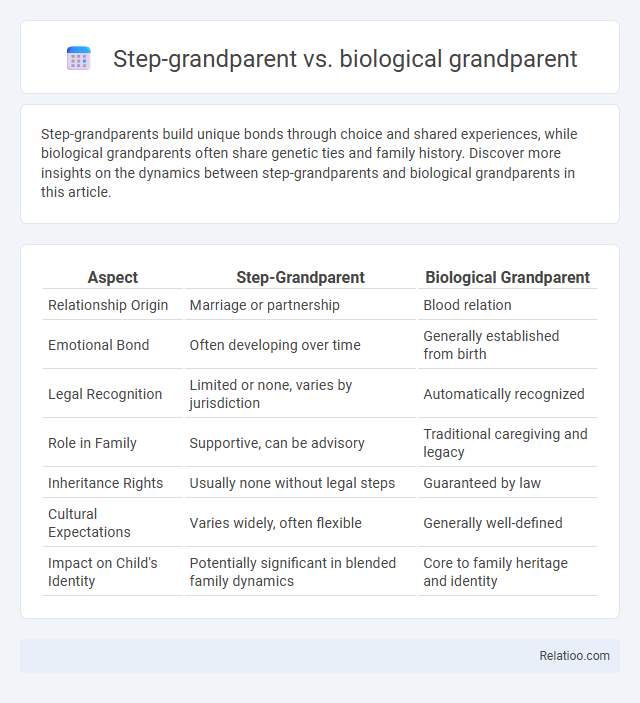Step-grandparents build unique bonds through choice and shared experiences, while biological grandparents often share genetic ties and family history. Discover more insights on the dynamics between step-grandparents and biological grandparents in this article.
Table of Comparison
| Aspect | Step-Grandparent | Biological Grandparent |
|---|---|---|
| Relationship Origin | Marriage or partnership | Blood relation |
| Emotional Bond | Often developing over time | Generally established from birth |
| Legal Recognition | Limited or none, varies by jurisdiction | Automatically recognized |
| Role in Family | Supportive, can be advisory | Traditional caregiving and legacy |
| Inheritance Rights | Usually none without legal steps | Guaranteed by law |
| Cultural Expectations | Varies widely, often flexible | Generally well-defined |
| Impact on Child's Identity | Potentially significant in blended family dynamics | Core to family heritage and identity |
Understanding Step-Grandparents and Biological Grandparents
Step-grandparents often provide emotional support and unique family perspectives that differ from those of biological grandparents, who share genetic ties and traditional family roles. Understanding the distinct contributions of both enhances your appreciation of family dynamics and strengthens intergenerational bonds. Recognizing these differences helps foster respect and meaningful connections across diverse family structures.
Legal Rights and Responsibilities
Step-grandparents typically have fewer legal rights and responsibilities compared to biological grandparents, as their status is often not recognized without formal adoption or legal guardianship. Biological grandparents may have visitation rights and responsibilities related to child welfare laws, depending on jurisdictional statutes designed to protect the child's best interests. Family role dynamics impact caregiving obligations, inheritance claims, and decision-making authority, where legal recognition of biological ties often supersedes social or non-biological relationships unless otherwise established by court orders.
Emotional Bonds and Family Dynamics
Step-grandparents often develop emotional bonds through shared experiences and intentional relationship-building, which can be just as meaningful as those with biological grandparents. Biological grandparents typically have inherent emotional ties rooted in genetics and family history, influencing multigenerational identity and legacy. Family dynamics vary widely, with step-grandparents frequently navigating boundaries and roles to foster inclusion and support within blended families.
Roles in Child Development
Step-grandparents often provide unique emotional support and mentorship, complementing the biological grandparent's role in transmitting family traditions and genetic heritage. Biological grandparents typically contribute to a child's identity formation and cultural continuity, while step-grandparents can enhance social development by offering additional stability and diverse perspectives. Understanding these distinct influences helps you recognize the multifaceted benefits each grandparent figure brings to your child's growth and well-being.
Challenges Faced by Step-Grandparents
Step-grandparents often encounter unique challenges, such as establishing trust and emotional bonds with step-grandchildren who may have strong attachments to their biological grandparents. Navigating family dynamics requires sensitivity to existing relationships while carving out a meaningful role without overstepping boundaries. You may also face difficulties in gaining recognition and acceptance within the family, making your role as impactful and supportive as that of a biological grandparent.
Acceptance in the Extended Family
Acceptance in the extended family varies significantly between step-grandparents and biological grandparents, often hinging on emotional bonds and social recognition rather than genetics alone. Biological grandparents typically benefit from established familial roles and traditions, fostering a sense of inherent acceptance, while step-grandparents must navigate building trust and connection to secure their place. Your active efforts in fostering genuine relationships and communication can enhance acceptance of step-grandparents within the broader family network.
Navigating Blended Family Relationships
Navigating blended family relationships requires understanding the unique roles of step-grandparents versus biological grandparents, as each contributes differently to your family's dynamic. Step-grandparents often build bonds through chosen affection and shared experiences, while biological grandparents may have legal and emotional ties rooted in blood relations. Acknowledging these distinctions helps foster respect, open communication, and a supportive environment for all family members.
Inheritance and Financial Considerations
Step-grandparents typically have no legal inheritance rights unless explicitly included in a will, whereas biological grandparents may have statutory claims depending on jurisdiction. Family roles often influence inheritance decisions, with familial closeness potentially affecting financial considerations and estate planning. You should ensure clear documentation to protect your financial interests and clarify inheritance expectations among all grandparent figures.
Cultural Views on Step and Biological Grandparents
Cultural views on step-grandparents and biological grandparents vary significantly, often influencing family dynamics and roles in caregiving and social support. Biological grandparents are typically regarded as primary kin with inherent rights and emotional bonds, while step-grandparents may be viewed through cultural lenses that emphasize either inclusion or distance based on societal norms and family acceptance. Studies highlight that in collectivist cultures, step-grandparents often gain recognition similar to biological grandparents due to the emphasis on extended family cohesion, whereas in individualist cultures, their roles tend to be more contingent on personal relationships and legal acknowledgment.
Supporting Healthy Grandparent-Grandchild Connections
Supporting healthy grandparent-grandchild connections involves understanding the unique dynamics of step-grandparents, biological grandparents, and family roles. Biological grandparents often provide a sense of genetic continuity and shared history, while step-grandparents can offer additional emotional support and broaden family networks when accepted positively. Effective family roles promote open communication, respect, and consistency, fostering strong intergenerational bonds that enhance grandchildren's emotional well-being and identity development.

Infographic: Step-Grandparent vs Biological Grandparent
 relatioo.com
relatioo.com